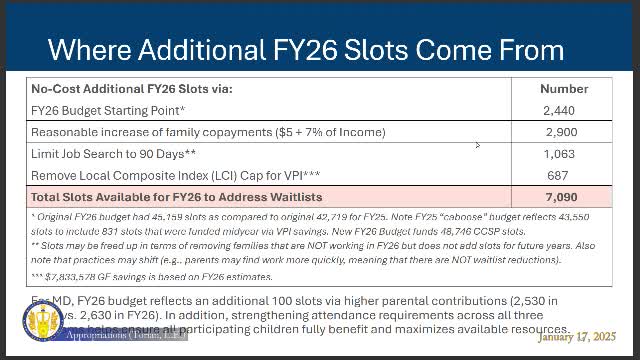Virginia Preschool Initiative aims to add 7000 slots amid rising child care demand
January 17, 2025 | 2025 Legislature VA, Virginia
This article was created by AI summarizing key points discussed. AI makes mistakes, so for full details and context, please refer to the video of the full meeting. Please report any errors so we can fix them. Report an error »

In a pivotal meeting held on January 17, 2025, Virginia's government officials gathered to discuss pressing issues surrounding early childhood education and child care subsidies. The atmosphere was charged with urgency as they examined strategies to address the growing waitlist for preschool slots and the challenges faced by families in accessing affordable child care.
The discussion highlighted a significant opportunity: by refining job search limitations and removing the local composite index cap for the Virginia Preschool Initiative, officials estimated they could potentially serve an additional 1,687 children this year alone. This adjustment could increase the total number of available slots to 7,000 without requiring additional funding, a prospect that could alleviate some of the pressure on families seeking early education for their children.
However, the meeting also revealed a troubling trend. Data presented showed a marked decline in regular attendance among young children in both the Virginia Preschool Initiative and child care programs, a situation exacerbated by health issues among infants and toddlers. This decline poses a risk to school readiness and long-term educational outcomes, prompting officials to seek solutions to encourage consistent attendance.
As the conversation shifted to school-age children, the need for a balanced approach became clear. While the budget aims to preserve existing slots for school-age care, officials acknowledged the necessity of reassessing funding structures. The current spending on after-school programs has surged to nearly $100 million annually, raising concerns about sustainability and equity in funding distribution.
Delegate Bridal voiced strong opposition to the governor's proposal to double co-pays for working families, emphasizing the potential burden on those already struggling. Despite the proposed changes, officials noted that even with full implementation, the waitlist would not be entirely eliminated, leaving approximately 1,600 children still without access to necessary services.
As the meeting concluded, the call for a collaborative work group emerged, aimed at bringing together various stakeholders to evaluate resources and expectations for quality in child care. This initiative reflects a growing recognition of the complexities involved in early childhood education funding and the urgent need to address the disparities faced by families across Virginia. The discussions from this meeting set the stage for future actions that could reshape the landscape of child care in the state, with the hope of ensuring that every child has access to the education they deserve.
The discussion highlighted a significant opportunity: by refining job search limitations and removing the local composite index cap for the Virginia Preschool Initiative, officials estimated they could potentially serve an additional 1,687 children this year alone. This adjustment could increase the total number of available slots to 7,000 without requiring additional funding, a prospect that could alleviate some of the pressure on families seeking early education for their children.
However, the meeting also revealed a troubling trend. Data presented showed a marked decline in regular attendance among young children in both the Virginia Preschool Initiative and child care programs, a situation exacerbated by health issues among infants and toddlers. This decline poses a risk to school readiness and long-term educational outcomes, prompting officials to seek solutions to encourage consistent attendance.
As the conversation shifted to school-age children, the need for a balanced approach became clear. While the budget aims to preserve existing slots for school-age care, officials acknowledged the necessity of reassessing funding structures. The current spending on after-school programs has surged to nearly $100 million annually, raising concerns about sustainability and equity in funding distribution.
Delegate Bridal voiced strong opposition to the governor's proposal to double co-pays for working families, emphasizing the potential burden on those already struggling. Despite the proposed changes, officials noted that even with full implementation, the waitlist would not be entirely eliminated, leaving approximately 1,600 children still without access to necessary services.
As the meeting concluded, the call for a collaborative work group emerged, aimed at bringing together various stakeholders to evaluate resources and expectations for quality in child care. This initiative reflects a growing recognition of the complexities involved in early childhood education funding and the urgent need to address the disparities faced by families across Virginia. The discussions from this meeting set the stage for future actions that could reshape the landscape of child care in the state, with the hope of ensuring that every child has access to the education they deserve.
View full meeting
This article is based on a recent meeting—watch the full video and explore the complete transcript for deeper insights into the discussion.
View full meeting
